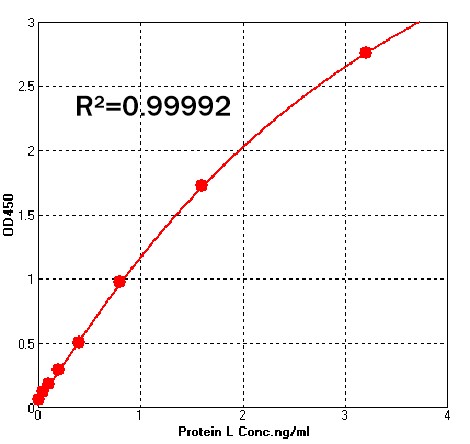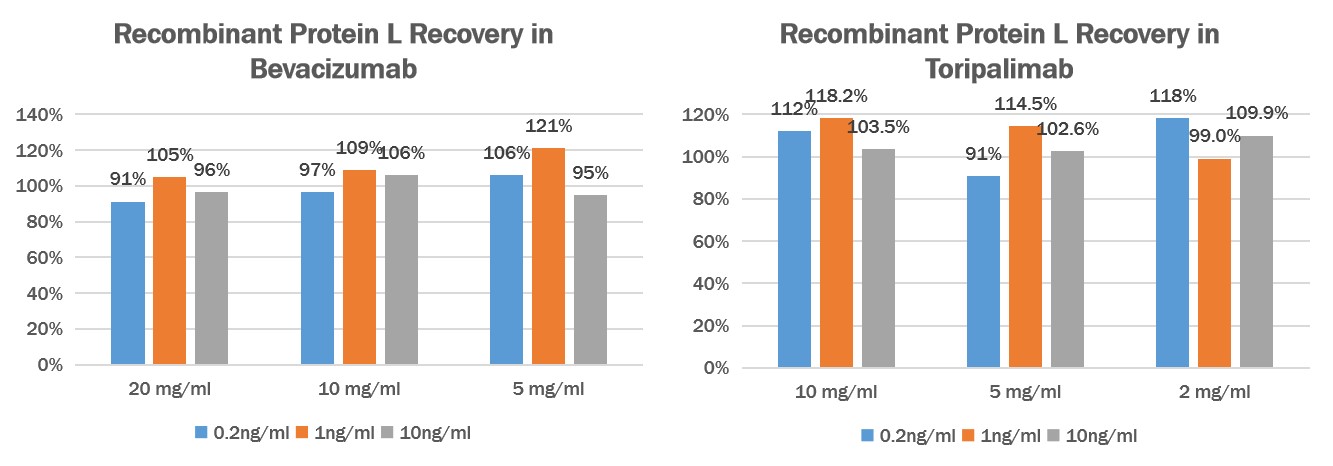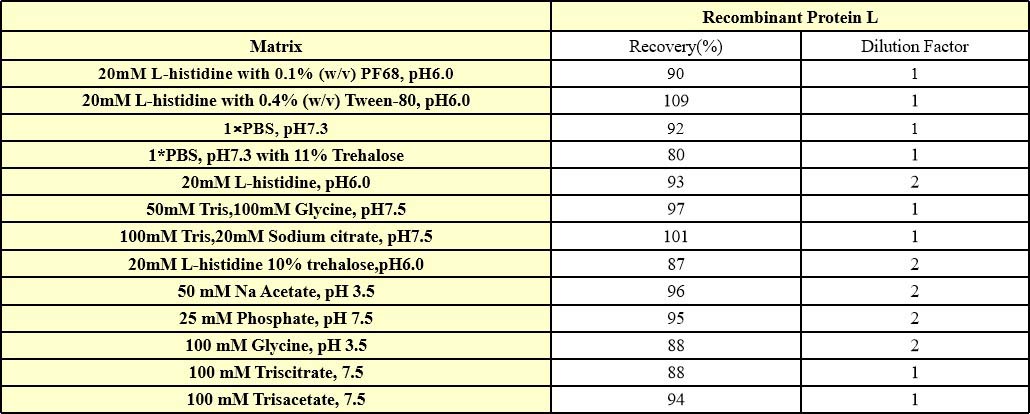 Request a FREE Sample of our FcRn Binding Kit!
Request a FREE Sample of our FcRn Binding Kit! Request a FREE Sample of our Fc gamma RI / CD64 Binding Kit !
Request a FREE Sample of our Fc gamma RI / CD64 Binding Kit !
 Limited Edition Golden Llama is here! Check out how you can get one.
Limited Edition Golden Llama is here! Check out how you can get one.  Limited Edition Golden Llama is here! Check out how you can get one.
Limited Edition Golden Llama is here! Check out how you can get one.
 Request a FREE sample of our GMP products!
Request a FREE sample of our GMP products!  Request a FREE sample of our GMP products!
Request a FREE sample of our GMP products!
| Assay Type | Sandwich-ELISA |
| Analyte | Protein L |
| Format | 96T |
| Regulatory Status | RUO |
| Sensitivity | <50pg/mL |
| Standard Curve Range | 50 pg/mL-3200 pg/mL |
| Assay Time | 2 hr |
| Suitable Sample Type | For the quantitative determination of recombinant protein L |
| Sample volume | 50uL |
The kit is developed for the detection of natural or structurally conserved recombinant forms of Protein L and a recombinant form of Protein L with very significant structural differences from natural Protein A such as MabSelectTM VL in Bioprocess manufacturing applications. It is used as a tool to aid in optimal purification process development and in routine quality control of in-process streams as well as final product .
It is for research use only.
The opened kit should be stored per components table. The shelf life is 30 days from the date of opening.
| ID | Components | Size |
| RES026-C01 | Pre-Coated Anti-Protein L Antibody Microplate | 1plate |
| RES026-C02 | Recombinant Protein L Standard (1μg/mL) | 100μL |
| RES026-C03 | Biotin-Anti-Protein L Antibody | 150uL |
| RES026-C04 | Streptavidin-HRP | 10μg |
| RES026-C05 | 10×Sample Dilution Buffer | 15mL |
| RES026-C06 | Denaturation Buffer | 15mL |
| RES026-C07 | 20×Washing Buffer | 30mL |
| RES026-C08 | Antibody Dilution Buffer | 15mL |
| RES026-C09 | Streptavidin-HRP Dilution Buffer | 15mL |
| RES026-C10 | Substrate Solution | 12mL |
| RES026-C11 | Stop Solution | 8mL |

Detection of Recombinant Protein L by sandwich-ELISA Assay. Immobilized Anti- Protein L Antibody can bind Recombinant Protein L . Detection was performed using Biotin-Anti- Protein L Antibody with sensitivity of 50 pg/mL. For each experiment, a standard curve needs to be set for each micro-plate, and the specific OD value may vary depending on different laboratories, testers, or equipments. The following example data is for reference only.
Three samples of known concentration were tested ten times on one plate to assess intra-assay precision.

Three samples of known concentration were tested in three separate assays to assess inter-assay precision.

Add different concentrations of Protein L (0.2ng/mL、1ng/mL、10ng/mL) to different concentrations of Human IgG1 (Bevacizumab) (20mg/mL、10mg/mL、5mg/mL) or Human IgG4 (Toripalimab) (10mg/mL、5mg/mL、2mg/mL), then dilute the antibodies to a reasonable range, then test and calculated the concentration of protein L to give the recovery rate.

We have conducted interference effect test about frequently-used buffers, they have excellent buffer compatibility. For specific buffers, it is recommended that you verify recovery to determine the minimum dilution ratio.

Host cell protein (HCP 500 ng/mL) and host cell DNA (HCD 0.5 ng/mL) of HEK293, E.coli or CHO systems were added to human IgG1 (Bevacizumab, 1mg/mL) and human IgG4 (Toripalimab, 1mg/mL), respectively, which were higher than the usual quality standard limit. Then high, medium, and low concentrations of Protein L were added, respectively, and the ratio of Protein L recovery in the Protein L added samples without HCP and HCD was added as the specificity verification index. verification index.


Explore our catalog of therapeutic antibody solutions to find the right products for you! We are dedicated to delivering solutions designed to help you drive innovation and push the boundaries of what therapeutic antibodies can be.

We offer a wide range of cell and gene therapy solutions starting from discovery to the clinic. Explore our wide range of proteins, antibodies, kits, and other assays to accelerate the development of your cell and gene therapy.

Organoid Toolbox is a collection of organoid solutions including ready-to-use organoids, organoid differentiation kits, and a variety of services to accelerate the progress of your drug development project.

ACROBiosystems developed a series of GMP grade cytokines under the GMP grade quality management system. Those products are all suitable for T/NK cell generation, activation, and proliferation in cell therapy research.

50+ targets designed for CAR detection, including PE/FITC/biotin labeled proteins. The key reagents for CD19 and BCMA were FDA DMF filed which can support your IND, NDA and BLA process.

Full length multi-pass TPs with stabilized structure and high bioactivity for immunization, antibody screening, cell based assay and CAR detection, including hot CD20, Claudin 18.2, CD133, GPRC5D,CCR8, CCR5, etc.

GMP grade cytokines, reagents for cell activation, gene edition, DNA/RNA removal, etc. Particularly focus on product design, quality control and solution-based support to link each phase of your cell and gene therapy journey.

A series of immune checkpoints including classic co-inhibitory and co-stimulatory receptors. The comprehensive catalog contains 100+ targets with various species and tags, and the high-quality proteins are in good batch-to-batch consistency.

To meet the needs of ADCs development, ACROBiosystems can provide: A variety of high-quality target proteins; MMPs/Cathepsin/uPA for cleavable linker; Anti-payload antibodies & anti-idiotypic antibodies for immunogenicity and PK analysis; SPR/BLI analytical and ADA development service.

Comprehensive collection of Fc receptor proteins, including their common variants, which can help expedite your antibody development.

Comprehensive cytokine targets including interleukins, growth factors, chemokines, TNFs, etc. are expressed by HEK293 to ensure their natural structure. Their high purity is verified by SDS-PAGE/HPLC/SEC-MALS and high bioactivity is verified by ELISA/SPR/BLI.

Aneuro provides innovative solutions for neuroscience research. Recombinant proteins, neural factors, pre-formed fibrils, electrophysiological electrodes, as well as Organoid Toolbox all in Aneuro aiming to advance neuroscience research, develop therapeutic interventions, and improve diagnostic methods for neurological diseases.
This web search service is supported by Google Inc.
